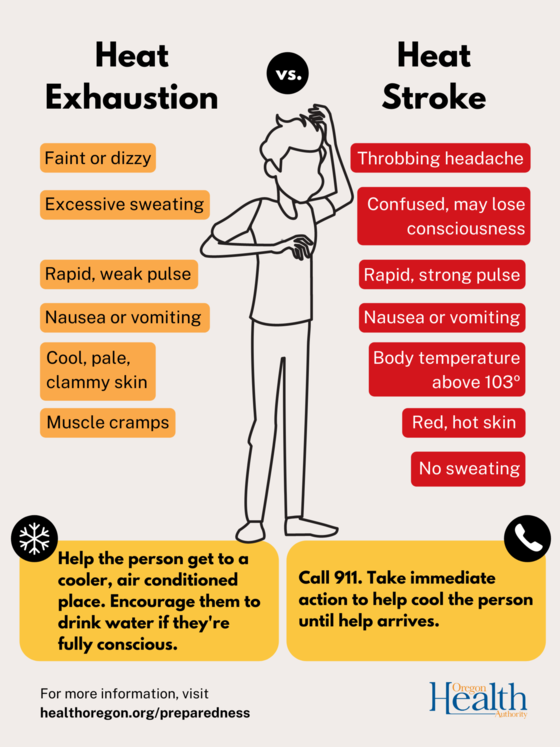Extreme caution advised as triple-digit temperatures expected
3 min read
Stay hydrated, stay informed, health officials say
PORTLAND, Ore., June 24, 2021 — Oregonians should take steps to prevent heat-related illnesses that can lead to heat exhaustion and heat stroke as summer temperatures are expected to climb into triple digits in many parts of the state in the coming days, state public health officials say.
“It’s critical that people do what they can to avoid the heat as temperatures get to the level where they can cause serious health problems,” said Richard Leman, public health physician at the Oregon Health Authority. “Temperatures that get above 100 are nothing to take casually. These conditions can be extremely dangerous if we don’t take care of ourselves.”
According to the National Weather Service, many parts of Oregon are expected to reach record-breaking temperatures, with highs reaching dangerous levels over the weekend, including up to 107 in the Portland area; up to 112 in southcentral and southwest Oregon; and up to 104 in central and eastern Oregon.
Thank you for supporting
local citizen journalism
The Oregon Health Authority offers the following tips for staying safe and healthy during extreme heat conditions:
- Stay cool
- Stay in air-conditioned places when temperatures are high, if possible. If you’re outside, find some shade.
- Limit exposure to the sun from 10 a.m. to 4 p.m. when UV rays are strongest. Try to schedule activities in the morning and evening.
- Avoid strenuous activity when it’s hot. This could lead to heat stroke.
- Open windows to allow fresh air to circulate, especially during morning and evening hours, and close shades on west-facing windows during the afternoon hours.
- Use portable electric fans to exhaust hot air from rooms or draw in cooler air.
- Wear loose-fitting clothing to keep cool and protect your skin from the sun.
- Use cool compresses, misting, and cool showers and baths.
- Avoid hot foods and heavy meals; they add heat to the body.
- Never leave infants, children, or pets in a parked car. They can suffer from heat-related illness.
- Dress infants and children in loose, lightweight, light-colored clothing.
- Use sunscreen with at least SPF 15 when going outside.
- Stay hydrated
- Regardless of your level of activity, drink plenty of fluids, even if you are not thirsty and especially when working outside.
- Avoid alcohol or liquids containing large amounts of sugar.
- Stay informed
- Keep up to date on the temperature and heat index when planning your activities so you can find ways to stay cool and hydrated. The heat index measures how hot it feels outside when factoring in humidity with the actual air temperature.
- Learn how to prevent, recognize and treat heat-related illnesses. Know the warning signs of heat stroke, heat exhaustion, heat cramps, sunburn, and heat rash, and how to treat and prevent them.
People with a chronic medical condition, such as heart disease, high blood pressure, diabetes, cancer or kidney disease, may be less likely to sense and respond to changes in temperature. Also, they may be taking medications that can worsen the impact of extreme heat. People in this category should be closely monitored to make sure they’re drinking enough water, have access to air conditioning and know how to keep cool.
Those who exercise in extreme heat or work outdoors are more likely to become dehydrated and get heat-related illness and should pay particular attention to staying as cool and hydrated as possible.
For more information, visit:
- Preventing Heat-related Illnesses (OHA): https://www.oregon.gov/oha/ph/Preparedness/Prepare/Pages/PrepareForExtremeHeat.aspx
- Extreme Heat (CDC): https://www.cdc.gov/disasters/extremeheat/index.html
- Warning Signs and Symptoms of Heat-related Illness (CDC): https://www.cdc.gov/disasters/extremeheat/warning.html



